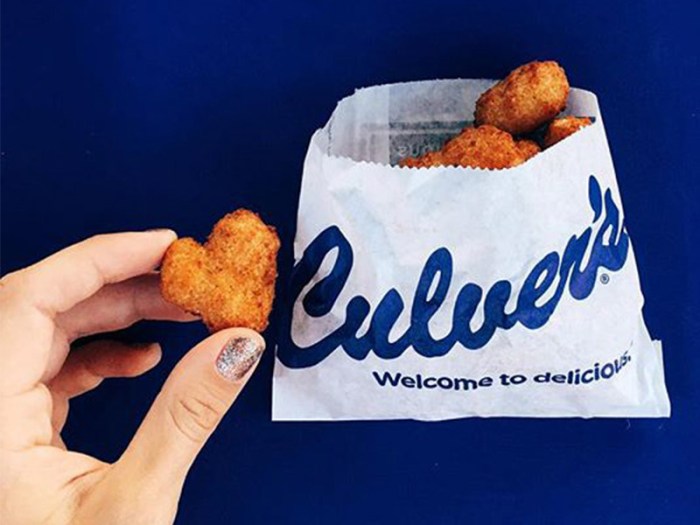Nutritional Impact and Dietary Considerations

Culver’s cheese curds nutrition information – Culver’s cheese curds, while undeniably delicious, pack a nutritional punch that needs careful consideration within the context of various dietary plans. Understanding their nutritional profile helps make informed choices about their inclusion in your overall diet. This section will explore how cheese curds fit into different dietary approaches and discuss their potential impact on health markers.Cheese curds are a relatively high-fat, high-protein, and moderate-calcium food.
Their suitability for different diets depends on individual needs and the overall composition of the meal.
Culver’s Cheese Curds and Dietary Plans, Culver’s cheese curds nutrition information
Culver’s cheese curds are a good source of protein, making them potentially suitable for high-protein diets aimed at building muscle mass or supporting weight management. However, their high fat content might pose a challenge for individuals following very low-fat diets. For those on a low-carb diet, cheese curds can be a reasonable choice as they are relatively low in carbohydrates.
Vegetarians and vegans, however, will need to look elsewhere, as cheese curds are a dairy product. The portion size is crucial; a small serving can easily be incorporated, while a large portion might significantly impact daily macronutrient targets.
Effects on Cholesterol, Blood Sugar, and Overall Health
The high saturated fat content in Culver’s cheese curds may potentially raise cholesterol levels in some individuals. This effect varies greatly depending on individual factors like genetics and overall dietary habits. Consuming them in moderation as part of a balanced diet is key. Their impact on blood sugar is relatively low due to their low carbohydrate content; however, the fat content might slow down digestion.
Overall, incorporating cheese curds into a healthy diet that includes plenty of fruits, vegetables, and whole grains, along with regular exercise, is unlikely to pose significant health risks for most people, but moderation is crucial. For individuals with pre-existing health conditions, consulting a doctor or registered dietitian before regularly consuming cheese curds is recommended.
Sample Meal Plan Incorporating Culver’s Cheese Curds
This sample meal plan incorporates a serving of Culver’s cheese curds (approximately 3 oz) and aims to meet a portion of daily nutritional needs. It’s important to adjust portion sizes based on individual caloric needs and dietary goals.
Breakfast: Oatmeal with berries and a sprinkle of nuts.
Lunch: Large salad with grilled chicken or fish, mixed greens, and a light vinaigrette. A small side of Culver’s cheese curds (3 oz).
Culver’s cheese curds, a purportedly wholesome snack, often mask their nutritional shortcomings behind a veneer of regional charm. A closer look at their fat and sodium content reveals a stark contrast to the seemingly healthier options, like the reduced-fat profile advertised for babybel cheese nutrition light , which highlights the deceptive marketing of “better-for-you” processed foods. Ultimately, the nutritional information for Culver’s cheese curds raises questions about the industry’s commitment to transparency regarding the true health impact of its products.
Dinner: Baked salmon with roasted vegetables (broccoli, carrots, sweet potatoes).
Snacks: Greek yogurt, fruits, or a small handful of almonds.
This meal plan provides a balance of protein, carbohydrates, and healthy fats. The cheese curds contribute protein and calcium, while the rest of the meal ensures a sufficient intake of vitamins, minerals, and fiber. Remember that this is just a sample, and individual needs may vary. Consult a nutrition professional for personalized dietary advice.
Comparison with Other Fast Food Sides

Culver’s cheese curds, while undeniably delicious, hold a unique place in the fast-food side dish landscape. To understand their nutritional profile better, let’s compare them to other popular choices like french fries and onion rings. This comparison will highlight the differences in calorie, fat, and sodium content, allowing for a more informed decision when choosing your next fast-food meal.
Understanding the nutritional differences between these sides helps make informed choices that contribute to a balanced diet. While occasional indulgence is fine, consistently choosing healthier options can positively impact overall health and well-being. Let’s examine the data to illustrate these differences.
Nutritional Comparison of Fast Food Sides
The following table provides a general comparison of Culver’s cheese curds against french fries and onion rings from other popular fast-food chains. Note that exact nutritional values can vary slightly depending on the specific restaurant, portion size, and preparation method. These figures represent average values based on readily available information from reputable sources.
| Item | Calories (approx.) | Fat (g, approx.) | Sodium (mg, approx.) |
|---|---|---|---|
| Culver’s Cheese Curds (small) | 250-300 | 15-20 | 400-500 |
| McDonald’s French Fries (small) | 230 | 11 | 170 |
| Arby’s Curly Fries (small) | 280 | 14 | 360 |
| Sonic Onion Rings (small) | 250-300 | 15-18 | 450-550 |
As you can see, the calorie and fat content are relatively similar across these items. However, sodium content is a significant factor to consider. Culver’s cheese curds and onion rings generally have considerably higher sodium levels than french fries. This difference stems largely from the ingredients and preparation methods.
Ingredient and Preparation Differences
The nutritional variations among these side items are primarily due to differences in ingredients and preparation methods. French fries are typically made from potatoes, fried in oil, and seasoned simply with salt. Onion rings, on the other hand, involve breading the onion slices, adding more fat and sodium during the frying process. Culver’s cheese curds are a unique product, being fried cheese curds.
This contributes to a higher fat and sodium content compared to plain french fries.
FAQ Overview: Culver’s Cheese Curds Nutrition Information
Are Culver’s cheese curds gluten-free?
Generally, yes, but always check the ingredient list for potential cross-contamination, as they are prepared in a facility that handles other items containing gluten.
How many cheese curds are in a typical serving?
The exact number varies, but a typical serving size is around a handful, approximately 1/2 cup.
Can I eat Culver’s cheese curds on a keto diet?
While high in fat, their carbohydrate content is relatively low, making them potentially suitable for a keto diet in moderation. However, individual carb tolerances vary, so monitor your intake carefully.
Are Culver’s cheese curds vegetarian?
Yes, Culver’s cheese curds are typically vegetarian. However, always double-check the ingredient list to confirm the absence of any animal-derived products.


